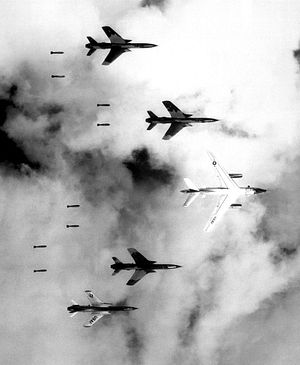A new survey on the use of aerial bombing during the Vietnam War has seemingly confirmed what many suspected: the systematic bombing of South Vietnam detracted from, rather than furthered, U.S. war aims. The study uses a U.S.-generated system of classifying individual Vietnamese hamlets to demonstrate that similarly positioned villages, subjected to different inputs (bombing), reacted differently.
Although methodologically complex, the upshot of the research is clear: areas subjected to aerial bombing tend to suffer from serious governance problems, both with respect to host country government and to foreign occupier. In the Vietnam War, areas targeted with bombing exhibited less trust of Americans and South Vietnamese authorities, and more trust of North Vietnamese soldiers and local insurgents. Such areas also suffered from greater economic problems, less civil society, and less effective local governance.
There are some methodological concerns; the study doesn’t account for different kinds of delivery systems (different types of aircraft attacked with varying levels of precision) and does not distinguish between air and artillery strikes. The description of “top-down” vs. “bottom-up” military strategies is a bit ambiguous, and dependent on older literature on the conflict. Nevertheless, the authors have done good work with the available data.
In short, the air campaign (at least as conducted in South Vietnam) did nothing to further U.S. war aims, and in fact contributed to the instability of the South Vietnamese government. Scholarship has long suggested that the bombing campaigns against North Vietnam had little productive effect on either ending the war or reducing North Vietnamese military capability; this study brings the entire airpower strategy associated with the war into question.
Of course, Vietnam is hardly the only Asian country to have been subjected to a long-term bombing campaign. The U.S. conducted some research on its World War II strategic bombing campaign against Japan, finding that bombing reduced morale and economic productivity, although not decisively. And the United States also heavily bombed North Korea during the Korean War; for obvious reasons, we lack good data on the reaction of the North Korean people.
To be fair, the research has some important limitations. The bombing campaigns of the Vietnam War have little in common with the air campaigns that the U.S. is currently pursuing in Pakistan, Yemen, and elsewhere. Airpower advocates argue that the precision of modern weaponry helps prevent the kind of effect that the authors describe. Of course, airpower advocates in the 1960s argued the same thing about the power and precision of extant bombing technology. As a general rule, American foreign policymakers should view airpower as a complicated and problematic tool for accomplishing U.S. international goals.

































